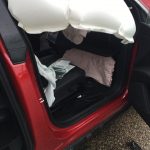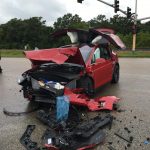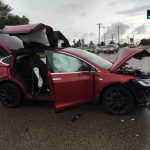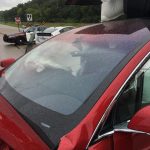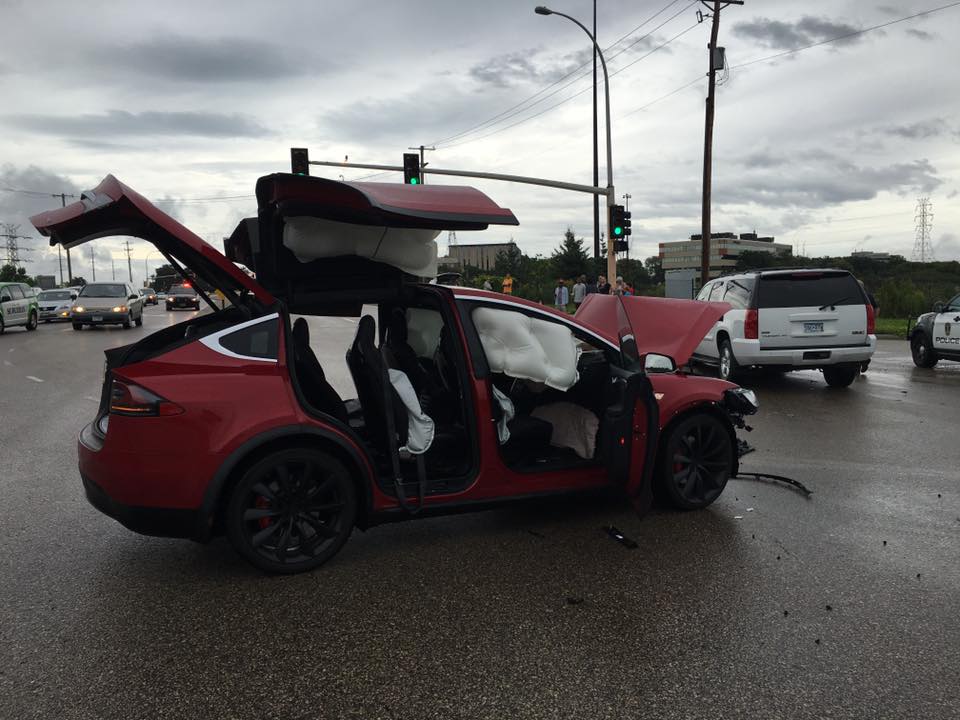

News
Tesla Model X saves family and pet after being struck at an intersection
“I waited 4 years for this one and would wait 4 more if that is what it took to protect my family like this” are the words that resonate in orthopaedic surgeon Jonathan Braman’s head after he and five passengers, plus their family pet, survived a horrific crash in their Tesla Model X.
According to Braman, he and his family were entering an intersection near E. Bush Lake Road in Bloomington, Minnesota when a GMC SUV ran through a red light at high speed striking the Model X near the right front quarter panel. The impact caused all airbags to deploy – some in areas Braman admits he didn’t realize existed – and provide safety around all passengers within the vehicle. Braman tells Teslarati, “I rapidly got out of the car and was lucky enough to have a group of young men who were behind me in line at the light help extract us from the car. I quickly got my family as far away from the GMC as I could. I was unsure if the gasoline in that car was stable and worried that his car would catch fire.”
Luckily everyone walked away unharmed. “We are alive. I’m pretty sure any other 7 passenger vehicle would have rolled if hit by this distracted Detroit Missile.”, says Braman.
What’s remarkable about this story is the fact that, despite being struck at high speed by a heavy and fast-moving SUV, and above the axis of rotation, the Model X didn’t roll. Braman who practices orthopaedic surgery and has been witness to some of the more extreme cases of spinal injury realizes the significance in this. Had the Model X rolled or even spun, there could have been serious neck and spinal injuries involved.
Braman’s father who was sitting inches from the point of impact was protected by the Model X’s large front crumple zone and airbags throughout, including never-before-seen leg airbags that deployed. “The other car was forced to glance off of us and came to a stop. The crumple zones worked, and my father who was sitting several inches from the point of impact was seen and discharged from the hospital. He would have been much more seriously injured if there were less safety protections. The leg airbags (and the others as well) deployed protecting him even further. The glass was not injured except by the airbag and never came out of any of the windows.”, tells us.
- Tesla Model X saves family after a horrific head-on crash [Photo: Jonathan Braman]
- Tesla Model X saves family after a horrific head-on crash [Photo: Jonathan Braman]
Despite being shook up from the incident, Braman a Roadster owner since 2010 says he waited over four years to receive his Model X P90D(L) and will wait another four if it means getting into a vehicle that will, not only protect the climate and his children’s future, but protect his family from this type of crash, and have them all walk away safely.
“I waited 4 years for this one and would wait 4 more if that is what it took to protect my family like this.”
This incident serves as a great example of why the Model X truly is the best car ever. Not because of the vehicle’s countless technological innovations: that’s a given, but because Tesla truly did put safety in mind before anything else. If you recall, CEO Elon Musk’s opening remark from the Model X unveiling event was around safety – something Braman’s story of survival can surely attest to.

News
Tesla starts showing how FSD will change lives in Europe
Local officials tested the system on narrow country roads and were impressed by FSD’s smooth, human-like driving, with some calling the service a game-changer for everyday life in areas that are far from urban centers.

Tesla has launched Europe’s first public shuttle service using Full Self-Driving (Supervised) in the rural Eifelkreis Bitburg-Prüm region of Germany, demonstrating how the technology can restore independence and mobility for people who struggle with limited transport options.
Local officials tested the system on narrow country roads and were impressed by FSD’s smooth, human-like driving, with some calling the service a game-changer for everyday life in areas that are far from urban centers.
Officials see real impact on rural residents
Arzfeld Mayor Johannes Kuhl and District Administrator Andreas Kruppert personally tested the Tesla shuttle service. This allowed them to see just how well FSD navigated winding lanes and rural roads confidently. Kruppert said, “Autonomous driving sounds like science fiction to many, but we simply see here that it works totally well in rural regions too.” Kuhl, for his part, also noted that FSD “feels like a very experienced driver.”
The pilot complements the area’s “Citizen Bus” program, which provides on-demand rides for elderly residents who can no longer drive themselves. Tesla Europe shared a video of a demonstration of the service, highlighting how FSD gives people their freedom back, even in places where public transport is not as prevalent.
What the Ministry for Economic Affairs and Transport says
Rhineland-Palatinate’s Minister Daniela Schmitt supported the project, praising the collaboration that made this “first of its kind in Europe” possible. As per the ministry, the rural rollout for the service shows FSD’s potential beyond major cities, and it delivers tangible benefits like grocery runs, doctor visits, and social connections for isolated residents.
“Reliable and flexible mobility is especially vital in rural areas. With the launch of a shuttle service using self-driving vehicles (FSD supervised) by Tesla in the Eifelkreis Bitburg-Prüm, an innovative pilot project is now getting underway that complements local community bus services. It is the first project of its kind in Europe.
“The result is a real gain for rural mobility: greater accessibility, more flexibility and tangible benefits for everyday life. A strong signal for innovation, cooperation and future-oriented mobility beyond urban centers,” the ministry wrote in a LinkedIn post.
News
Tesla China quietly posts Robotaxi-related job listing
Tesla China is currently seeking a Low Voltage Electrical Engineer to work on circuit board design for the company’s autonomous vehicles.

Tesla has posted a new job listing in Shanghai explicitly tied to its Robotaxi program, fueling speculation that the company is preparing to launch its dedicated autonomous ride-hailing service in China.
As noted in the listing, Tesla China is currently seeking a Low Voltage Electrical Engineer to work on circuit board design for the company’s autonomous vehicles.
Robotaxi-specific role
The listing, which was shared on social media platform X by industry watcher @tslaming, suggested that Tesla China is looking to fill the role urgently. The job listing itself specifically mentions that the person hired for the role will be working on the Low Voltage Hardware team, which would design the circuit boards that would serve as the nervous system of the Robotaxi.
Key tasks for the role, as indicated in the job listing, include collaboration with PCB layout, firmware, mechanical, program management, and validation teams, among other responsibilities. The role is based in Shanghai.
China Robotaxi launch
China represents a massive potential market for robotaxis, with its dense urban centers and supportive policies in select cities. Tesla has limited permission to roll out FSD in the country, though despite this, its vehicles have been hailed as among the best in the market when it comes to autonomous features. So far, at least, it appears that China supports Tesla’s FSD and Robotaxi rollout.
This was hinted at in November, when Tesla brought the Cybercab to the 8th China International Import Expo (CIIE) in Shanghai, marking the first time that the autonomous two-seater was brought to the Asia-Pacific region. The vehicle, despite not having a release date in China, received a significant amount of interest among the event’s attendees.
Elon Musk
Elon Musk and Tesla AI Director share insights after empty driver seat Robotaxi rides
The executives’ unoccupied tests hint at the rapid progress of Tesla’s unsupervised Robotaxi efforts.

Tesla CEO Elon Musk and AI Director Ashok Elluswamy celebrated Christmas Eve by sharing personal experiences with Robotaxi vehicles that had no safety monitor or occupant in the driver’s seat. Musk described the system’s “perfect driving” around Austin, while Elluswamy posted video from the back seat, calling it “an amazing experience.”
The executives’ unoccupied tests hint at the rapid progress of Tesla’s unsupervised Robotaxi efforts.
Elon and Ashok’s firsthand Robotaxi insights
Prior to Musk and the Tesla AI Director’s posts, sightings of unmanned Teslas navigating public roads were widely shared on social media. One such vehicle was spotted in Austin, Texas, which Elon Musk acknowleged by stating that “Testing is underway with no occupants in the car.”
Based on his Christmas Eve post, Musk seemed to have tested an unmanned Tesla himself. “A Tesla with no safety monitor in the car and me sitting in the passenger seat took me all around Austin on Sunday with perfect driving,” Musk wrote in his post.
Elluswamy responded with a 2-minute video showing himself in the rear of an unmanned Tesla. The video featured the vehicle’s empty front seats, as well as its smooth handling through real-world traffic. He captioned his video with the words, “It’s an amazing experience!”
Towards Unsupervised operations
During an xAI Hackathon earlier this month, Elon Musk mentioned that Tesla owed be removing Safety Monitors from its Robotaxis in Austin in just three weeks. “Unsupervised is pretty much solved at this point. So there will be Tesla Robotaxis operating in Austin with no one in them. Not even anyone in the passenger seat in about three weeks,” he said. Musk echoed similar estimates at the 2025 Annual Shareholder Meeting and the Q3 2025 earnings call.
Considering the insights that were posted Musk and Elluswamy, it does appear that Tesla is working hard towards operating its Robotaxis with no safety monitors. This is quite impressive considering that the service was launched just earlier this year.

